Organisational Behaviour: Reflection on Group Work Experience Report
VerifiedAdded on 2023/01/16
|6
|1415
|65
Report
AI Summary
This report is a reflective analysis of a student's group work experience, focusing on the application of organisational behaviour (OB) concepts and theories. The report begins with an introduction to organisational behaviour and its relevance in group dynamics. The main body details the student's personal experience within a group project, highlighting the challenges faced, such as differing work styles and communication issues, and how these were overcome. The student discusses their role, strengths, and areas for improvement within the team, and how the team leader's skills helped. The report then delves into four key OB concepts – Gibbs reflective cycle, Vroom's Expectancy Theory, the Theory of Cognitive Dissonance, and Self-Perception Theory – and illustrates how these concepts manifested in the group setting. The student provides specific examples of how each theory helped understand and navigate the team's dynamics, motivation, and behaviours. The conclusion summarizes the key learnings from the experience, emphasizing the importance of group work for personal and skill development, and the practical application of OB theories. This report demonstrates the student's ability to reflect on their experiences and connect them to theoretical frameworks, providing valuable insights into teamwork and organisational behaviour.
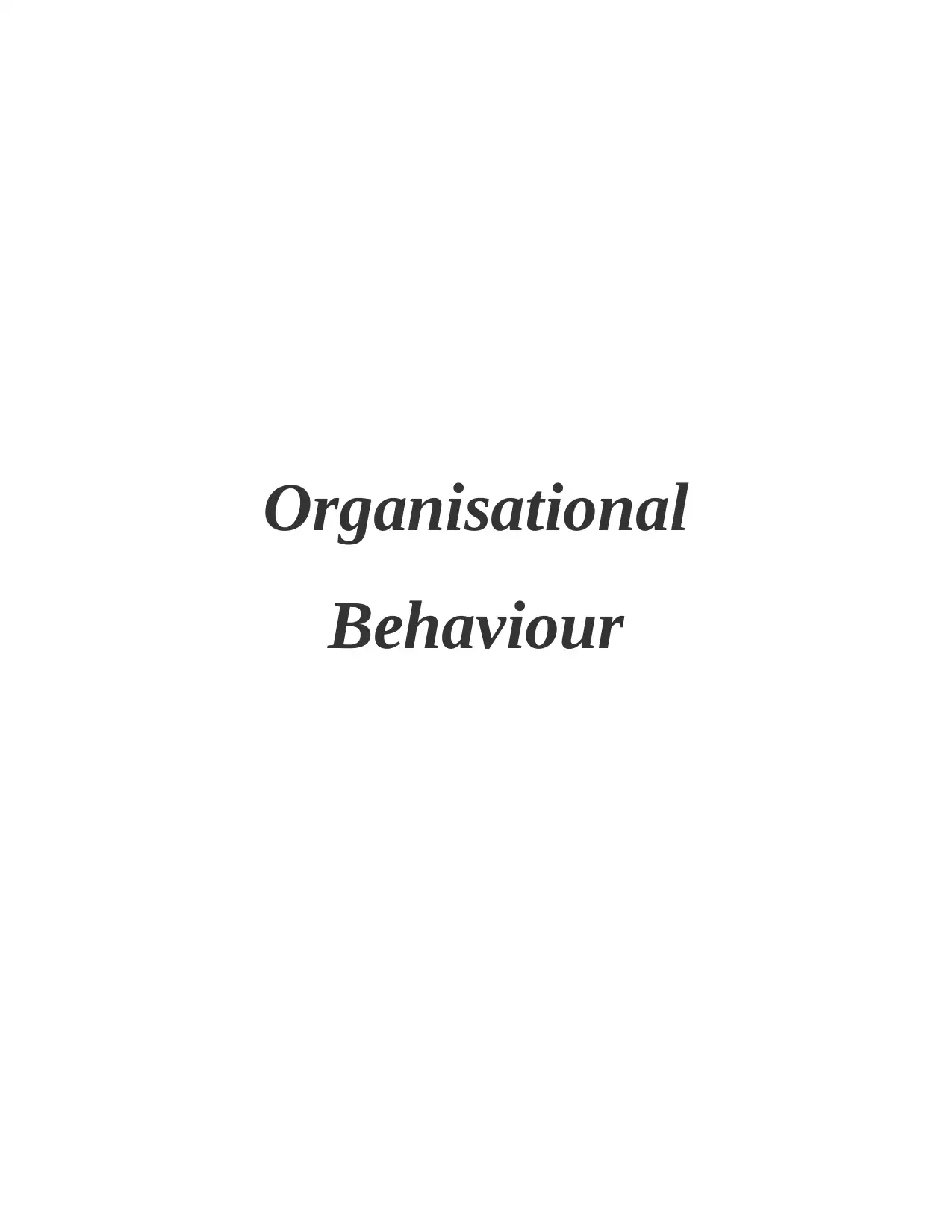
Organisational
Behaviour
Behaviour
Paraphrase This Document
Need a fresh take? Get an instant paraphrase of this document with our AI Paraphraser
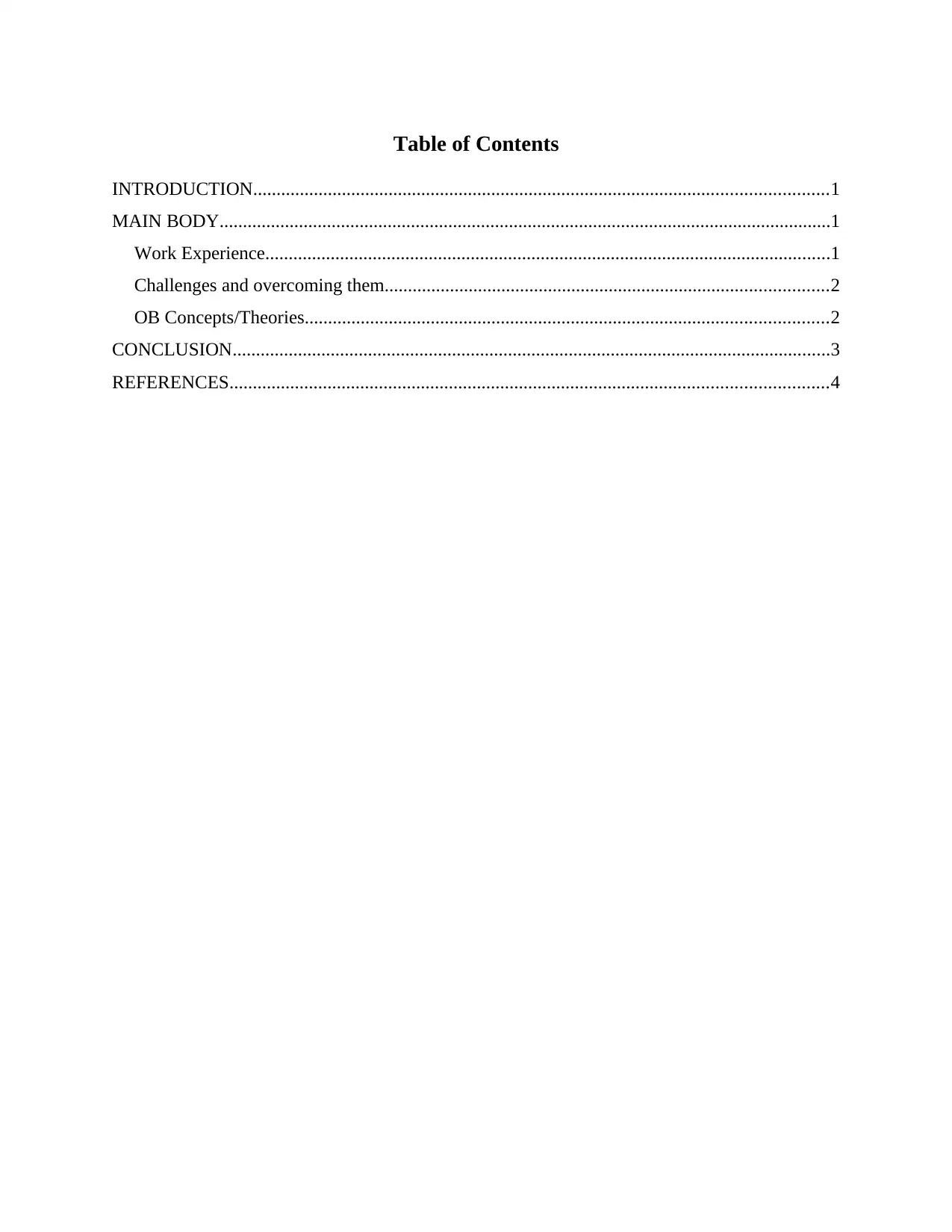
Table of Contents
INTRODUCTION...........................................................................................................................1
MAIN BODY...................................................................................................................................1
Work Experience.........................................................................................................................1
Challenges and overcoming them...............................................................................................2
OB Concepts/Theories................................................................................................................2
CONCLUSION................................................................................................................................3
REFERENCES................................................................................................................................4
INTRODUCTION...........................................................................................................................1
MAIN BODY...................................................................................................................................1
Work Experience.........................................................................................................................1
Challenges and overcoming them...............................................................................................2
OB Concepts/Theories................................................................................................................2
CONCLUSION................................................................................................................................3
REFERENCES................................................................................................................................4
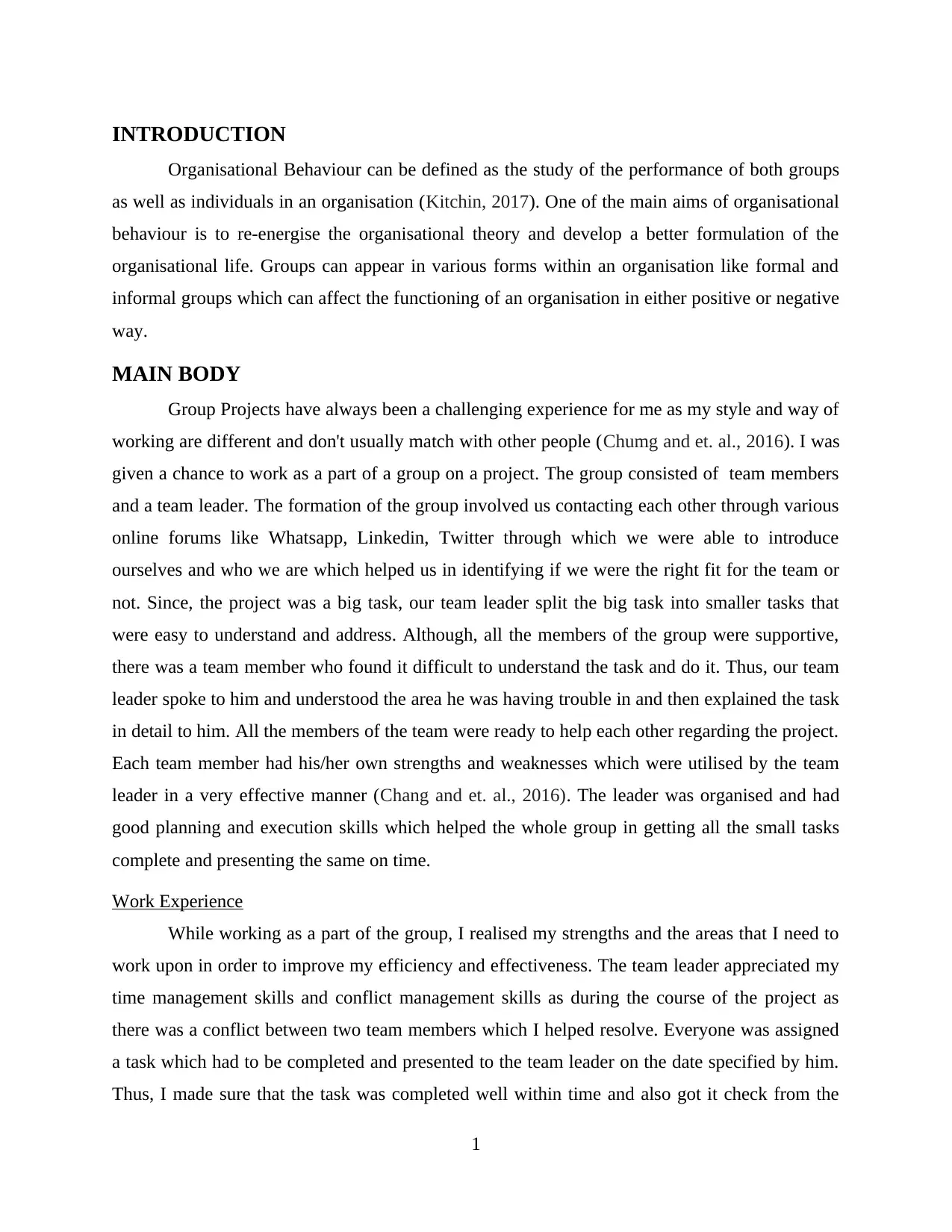
INTRODUCTION
Organisational Behaviour can be defined as the study of the performance of both groups
as well as individuals in an organisation (Kitchin, 2017). One of the main aims of organisational
behaviour is to re-energise the organisational theory and develop a better formulation of the
organisational life. Groups can appear in various forms within an organisation like formal and
informal groups which can affect the functioning of an organisation in either positive or negative
way.
MAIN BODY
Group Projects have always been a challenging experience for me as my style and way of
working are different and don't usually match with other people (Chumg and et. al., 2016). I was
given a chance to work as a part of a group on a project. The group consisted of team members
and a team leader. The formation of the group involved us contacting each other through various
online forums like Whatsapp, Linkedin, Twitter through which we were able to introduce
ourselves and who we are which helped us in identifying if we were the right fit for the team or
not. Since, the project was a big task, our team leader split the big task into smaller tasks that
were easy to understand and address. Although, all the members of the group were supportive,
there was a team member who found it difficult to understand the task and do it. Thus, our team
leader spoke to him and understood the area he was having trouble in and then explained the task
in detail to him. All the members of the team were ready to help each other regarding the project.
Each team member had his/her own strengths and weaknesses which were utilised by the team
leader in a very effective manner (Chang and et. al., 2016). The leader was organised and had
good planning and execution skills which helped the whole group in getting all the small tasks
complete and presenting the same on time.
Work Experience
While working as a part of the group, I realised my strengths and the areas that I need to
work upon in order to improve my efficiency and effectiveness. The team leader appreciated my
time management skills and conflict management skills as during the course of the project as
there was a conflict between two team members which I helped resolve. Everyone was assigned
a task which had to be completed and presented to the team leader on the date specified by him.
Thus, I made sure that the task was completed well within time and also got it check from the
1
Organisational Behaviour can be defined as the study of the performance of both groups
as well as individuals in an organisation (Kitchin, 2017). One of the main aims of organisational
behaviour is to re-energise the organisational theory and develop a better formulation of the
organisational life. Groups can appear in various forms within an organisation like formal and
informal groups which can affect the functioning of an organisation in either positive or negative
way.
MAIN BODY
Group Projects have always been a challenging experience for me as my style and way of
working are different and don't usually match with other people (Chumg and et. al., 2016). I was
given a chance to work as a part of a group on a project. The group consisted of team members
and a team leader. The formation of the group involved us contacting each other through various
online forums like Whatsapp, Linkedin, Twitter through which we were able to introduce
ourselves and who we are which helped us in identifying if we were the right fit for the team or
not. Since, the project was a big task, our team leader split the big task into smaller tasks that
were easy to understand and address. Although, all the members of the group were supportive,
there was a team member who found it difficult to understand the task and do it. Thus, our team
leader spoke to him and understood the area he was having trouble in and then explained the task
in detail to him. All the members of the team were ready to help each other regarding the project.
Each team member had his/her own strengths and weaknesses which were utilised by the team
leader in a very effective manner (Chang and et. al., 2016). The leader was organised and had
good planning and execution skills which helped the whole group in getting all the small tasks
complete and presenting the same on time.
Work Experience
While working as a part of the group, I realised my strengths and the areas that I need to
work upon in order to improve my efficiency and effectiveness. The team leader appreciated my
time management skills and conflict management skills as during the course of the project as
there was a conflict between two team members which I helped resolve. Everyone was assigned
a task which had to be completed and presented to the team leader on the date specified by him.
Thus, I made sure that the task was completed well within time and also got it check from the
1
⊘ This is a preview!⊘
Do you want full access?
Subscribe today to unlock all pages.

Trusted by 1+ million students worldwide
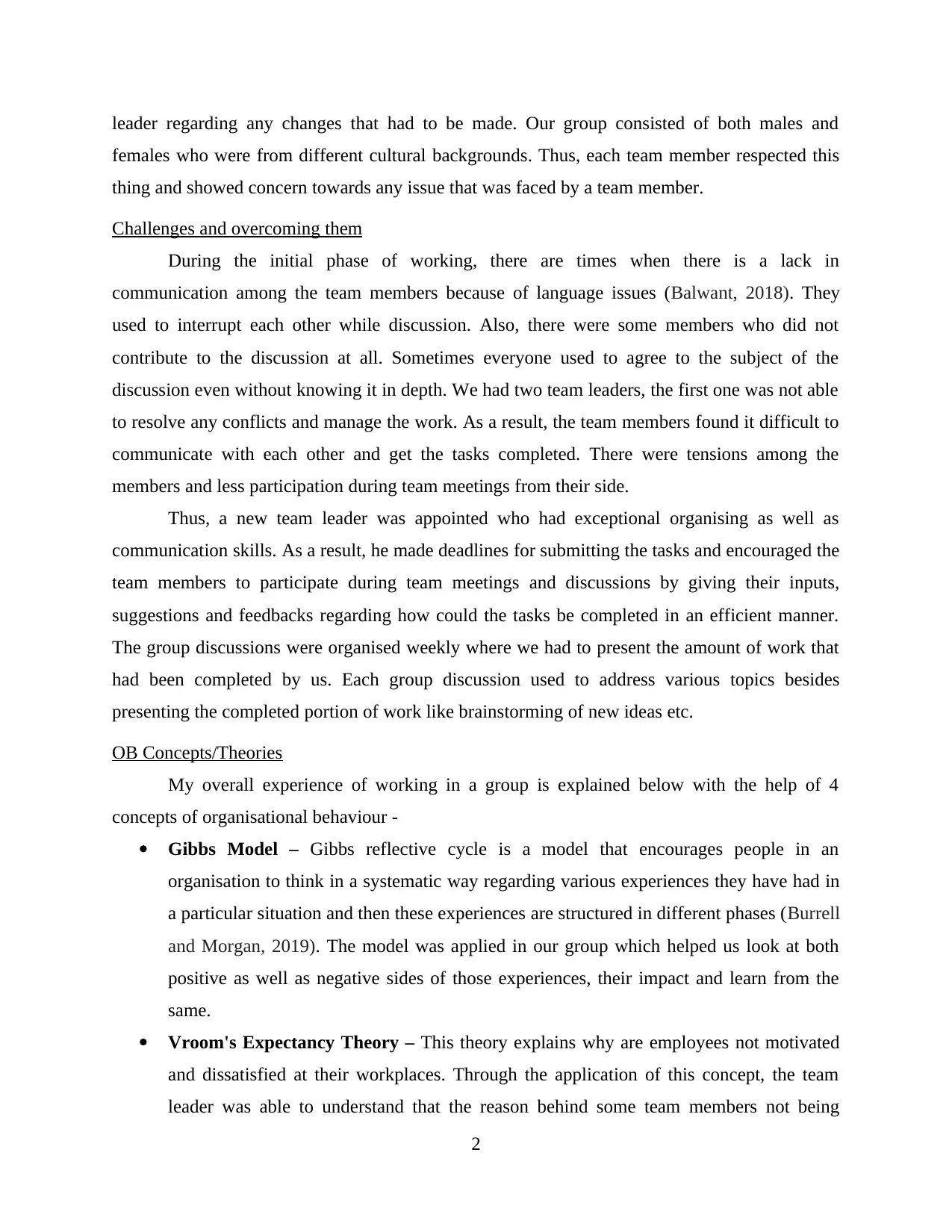
leader regarding any changes that had to be made. Our group consisted of both males and
females who were from different cultural backgrounds. Thus, each team member respected this
thing and showed concern towards any issue that was faced by a team member.
Challenges and overcoming them
During the initial phase of working, there are times when there is a lack in
communication among the team members because of language issues (Balwant, 2018). They
used to interrupt each other while discussion. Also, there were some members who did not
contribute to the discussion at all. Sometimes everyone used to agree to the subject of the
discussion even without knowing it in depth. We had two team leaders, the first one was not able
to resolve any conflicts and manage the work. As a result, the team members found it difficult to
communicate with each other and get the tasks completed. There were tensions among the
members and less participation during team meetings from their side.
Thus, a new team leader was appointed who had exceptional organising as well as
communication skills. As a result, he made deadlines for submitting the tasks and encouraged the
team members to participate during team meetings and discussions by giving their inputs,
suggestions and feedbacks regarding how could the tasks be completed in an efficient manner.
The group discussions were organised weekly where we had to present the amount of work that
had been completed by us. Each group discussion used to address various topics besides
presenting the completed portion of work like brainstorming of new ideas etc.
OB Concepts/Theories
My overall experience of working in a group is explained below with the help of 4
concepts of organisational behaviour -
Gibbs Model – Gibbs reflective cycle is a model that encourages people in an
organisation to think in a systematic way regarding various experiences they have had in
a particular situation and then these experiences are structured in different phases (Burrell
and Morgan, 2019). The model was applied in our group which helped us look at both
positive as well as negative sides of those experiences, their impact and learn from the
same.
Vroom's Expectancy Theory – This theory explains why are employees not motivated
and dissatisfied at their workplaces. Through the application of this concept, the team
leader was able to understand that the reason behind some team members not being
2
females who were from different cultural backgrounds. Thus, each team member respected this
thing and showed concern towards any issue that was faced by a team member.
Challenges and overcoming them
During the initial phase of working, there are times when there is a lack in
communication among the team members because of language issues (Balwant, 2018). They
used to interrupt each other while discussion. Also, there were some members who did not
contribute to the discussion at all. Sometimes everyone used to agree to the subject of the
discussion even without knowing it in depth. We had two team leaders, the first one was not able
to resolve any conflicts and manage the work. As a result, the team members found it difficult to
communicate with each other and get the tasks completed. There were tensions among the
members and less participation during team meetings from their side.
Thus, a new team leader was appointed who had exceptional organising as well as
communication skills. As a result, he made deadlines for submitting the tasks and encouraged the
team members to participate during team meetings and discussions by giving their inputs,
suggestions and feedbacks regarding how could the tasks be completed in an efficient manner.
The group discussions were organised weekly where we had to present the amount of work that
had been completed by us. Each group discussion used to address various topics besides
presenting the completed portion of work like brainstorming of new ideas etc.
OB Concepts/Theories
My overall experience of working in a group is explained below with the help of 4
concepts of organisational behaviour -
Gibbs Model – Gibbs reflective cycle is a model that encourages people in an
organisation to think in a systematic way regarding various experiences they have had in
a particular situation and then these experiences are structured in different phases (Burrell
and Morgan, 2019). The model was applied in our group which helped us look at both
positive as well as negative sides of those experiences, their impact and learn from the
same.
Vroom's Expectancy Theory – This theory explains why are employees not motivated
and dissatisfied at their workplaces. Through the application of this concept, the team
leader was able to understand that the reason behind some team members not being
2
Paraphrase This Document
Need a fresh take? Get an instant paraphrase of this document with our AI Paraphraser
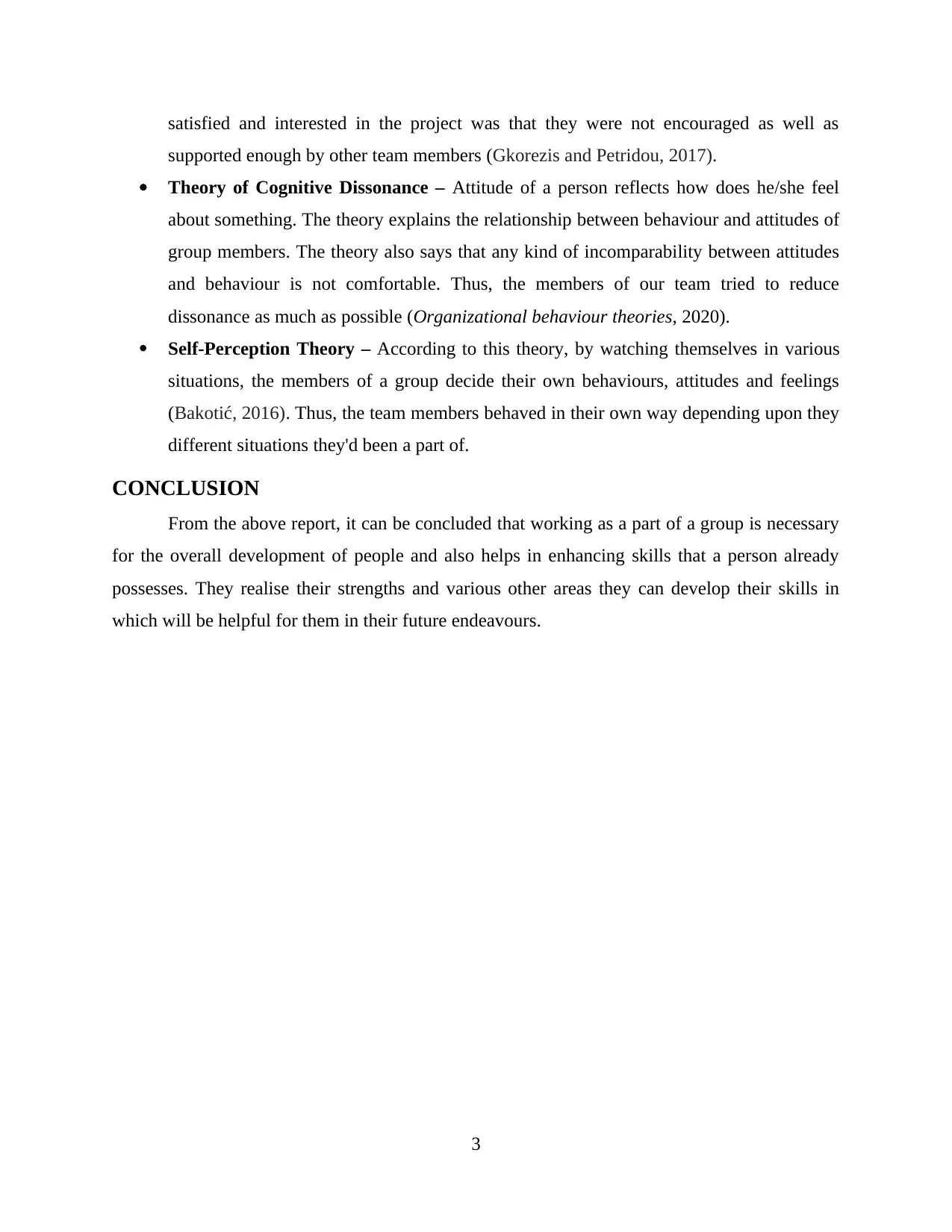
satisfied and interested in the project was that they were not encouraged as well as
supported enough by other team members (Gkorezis and Petridou, 2017).
Theory of Cognitive Dissonance – Attitude of a person reflects how does he/she feel
about something. The theory explains the relationship between behaviour and attitudes of
group members. The theory also says that any kind of incomparability between attitudes
and behaviour is not comfortable. Thus, the members of our team tried to reduce
dissonance as much as possible (Organizational behaviour theories, 2020).
Self-Perception Theory – According to this theory, by watching themselves in various
situations, the members of a group decide their own behaviours, attitudes and feelings
(Bakotić, 2016). Thus, the team members behaved in their own way depending upon they
different situations they'd been a part of.
CONCLUSION
From the above report, it can be concluded that working as a part of a group is necessary
for the overall development of people and also helps in enhancing skills that a person already
possesses. They realise their strengths and various other areas they can develop their skills in
which will be helpful for them in their future endeavours.
3
supported enough by other team members (Gkorezis and Petridou, 2017).
Theory of Cognitive Dissonance – Attitude of a person reflects how does he/she feel
about something. The theory explains the relationship between behaviour and attitudes of
group members. The theory also says that any kind of incomparability between attitudes
and behaviour is not comfortable. Thus, the members of our team tried to reduce
dissonance as much as possible (Organizational behaviour theories, 2020).
Self-Perception Theory – According to this theory, by watching themselves in various
situations, the members of a group decide their own behaviours, attitudes and feelings
(Bakotić, 2016). Thus, the team members behaved in their own way depending upon they
different situations they'd been a part of.
CONCLUSION
From the above report, it can be concluded that working as a part of a group is necessary
for the overall development of people and also helps in enhancing skills that a person already
possesses. They realise their strengths and various other areas they can develop their skills in
which will be helpful for them in their future endeavours.
3
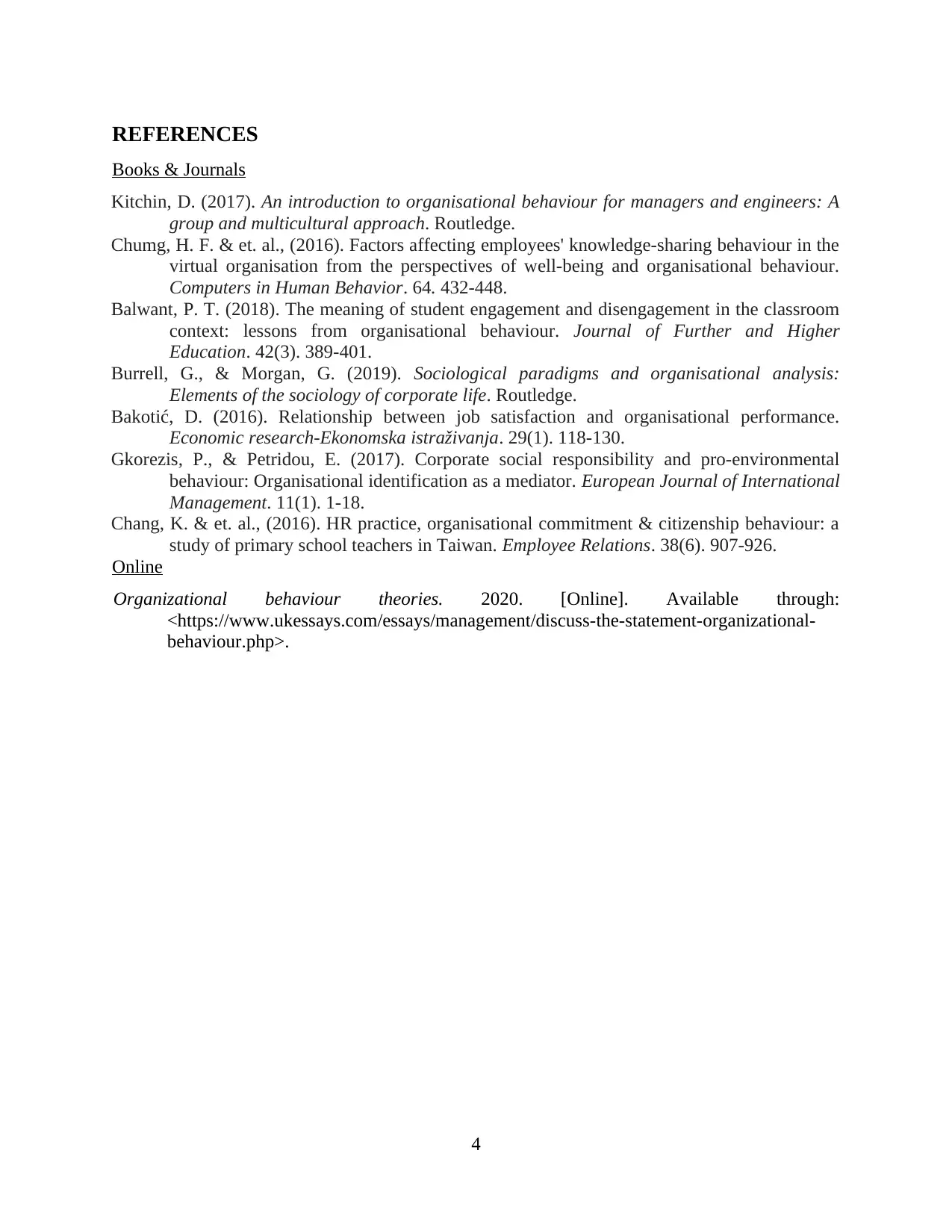
REFERENCES
Books & Journals
Kitchin, D. (2017). An introduction to organisational behaviour for managers and engineers: A
group and multicultural approach. Routledge.
Chumg, H. F. & et. al., (2016). Factors affecting employees' knowledge-sharing behaviour in the
virtual organisation from the perspectives of well-being and organisational behaviour.
Computers in Human Behavior. 64. 432-448.
Balwant, P. T. (2018). The meaning of student engagement and disengagement in the classroom
context: lessons from organisational behaviour. Journal of Further and Higher
Education. 42(3). 389-401.
Burrell, G., & Morgan, G. (2019). Sociological paradigms and organisational analysis:
Elements of the sociology of corporate life. Routledge.
Bakotić, D. (2016). Relationship between job satisfaction and organisational performance.
Economic research-Ekonomska istraživanja. 29(1). 118-130.
Gkorezis, P., & Petridou, E. (2017). Corporate social responsibility and pro-environmental
behaviour: Organisational identification as a mediator. European Journal of International
Management. 11(1). 1-18.
Chang, K. & et. al., (2016). HR practice, organisational commitment & citizenship behaviour: a
study of primary school teachers in Taiwan. Employee Relations. 38(6). 907-926.
Online
Organizational behaviour theories. 2020. [Online]. Available through:
<https://www.ukessays.com/essays/management/discuss-the-statement-organizational-
behaviour.php>.
4
Books & Journals
Kitchin, D. (2017). An introduction to organisational behaviour for managers and engineers: A
group and multicultural approach. Routledge.
Chumg, H. F. & et. al., (2016). Factors affecting employees' knowledge-sharing behaviour in the
virtual organisation from the perspectives of well-being and organisational behaviour.
Computers in Human Behavior. 64. 432-448.
Balwant, P. T. (2018). The meaning of student engagement and disengagement in the classroom
context: lessons from organisational behaviour. Journal of Further and Higher
Education. 42(3). 389-401.
Burrell, G., & Morgan, G. (2019). Sociological paradigms and organisational analysis:
Elements of the sociology of corporate life. Routledge.
Bakotić, D. (2016). Relationship between job satisfaction and organisational performance.
Economic research-Ekonomska istraživanja. 29(1). 118-130.
Gkorezis, P., & Petridou, E. (2017). Corporate social responsibility and pro-environmental
behaviour: Organisational identification as a mediator. European Journal of International
Management. 11(1). 1-18.
Chang, K. & et. al., (2016). HR practice, organisational commitment & citizenship behaviour: a
study of primary school teachers in Taiwan. Employee Relations. 38(6). 907-926.
Online
Organizational behaviour theories. 2020. [Online]. Available through:
<https://www.ukessays.com/essays/management/discuss-the-statement-organizational-
behaviour.php>.
4
⊘ This is a preview!⊘
Do you want full access?
Subscribe today to unlock all pages.

Trusted by 1+ million students worldwide
1 out of 6
Related Documents
Your All-in-One AI-Powered Toolkit for Academic Success.
+13062052269
info@desklib.com
Available 24*7 on WhatsApp / Email
![[object Object]](/_next/static/media/star-bottom.7253800d.svg)
Unlock your academic potential
Copyright © 2020–2025 A2Z Services. All Rights Reserved. Developed and managed by ZUCOL.





